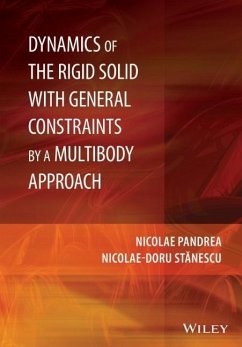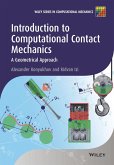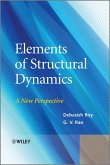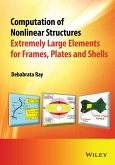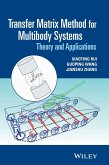Nicolae Pandrea, Nicolae-Doru Stanescu
Dynamics of the Rigid Solid with General Constraints by a Multibody Approach
Nicolae Pandrea, Nicolae-Doru Stanescu
Dynamics of the Rigid Solid with General Constraints by a Multibody Approach
- Gebundenes Buch
- Merkliste
- Auf die Merkliste
- Bewerten Bewerten
- Teilen
- Produkt teilen
- Produkterinnerung
- Produkterinnerung
Covers both holonomic and non-holonomic constraints in a study of the mechanics of the constrained rigid body. * Covers all types of general constraints applicable to the solid rigid * Performs calculations in matrix form * Provides algorithms for the numerical calculations for each type of constraint * Includes solved numerical examples * Accompanied by a website hosting programs
Andere Kunden interessierten sich auch für
![Introduction to Computational Contact Mechanics Introduction to Computational Contact Mechanics]() Alexander KonyukhovIntroduction to Computational Contact Mechanics131,99 €
Alexander KonyukhovIntroduction to Computational Contact Mechanics131,99 €![Flexible Multibody Dynamics Flexible Multibody Dynamics]() Michel GéradinFlexible Multibody Dynamics226,99 €
Michel GéradinFlexible Multibody Dynamics226,99 €![Elements of Structural Dynamics Elements of Structural Dynamics]() Debasish RoyElements of Structural Dynamics139,99 €
Debasish RoyElements of Structural Dynamics139,99 €![Computation of Nonlinear Structures Computation of Nonlinear Structures]() Debabrata RayComputation of Nonlinear Structures172,99 €
Debabrata RayComputation of Nonlinear Structures172,99 €![Transfer Matrix Method for Multibody Systems Transfer Matrix Method for Multibody Systems]() Xiaoting RuiTransfer Matrix Method for Multibody Systems182,99 €
Xiaoting RuiTransfer Matrix Method for Multibody Systems182,99 €![Kinematic Differential Geometry and Saddle Synthesis of Linkages Kinematic Differential Geometry and Saddle Synthesis of Linkages]() Delun WangKinematic Differential Geometry and Saddle Synthesis of Linkages193,99 €
Delun WangKinematic Differential Geometry and Saddle Synthesis of Linkages193,99 €![Extended Finite Element Method Extended Finite Element Method]() Amir R. KhoeiExtended Finite Element Method171,99 €
Amir R. KhoeiExtended Finite Element Method171,99 €-
-
-
Covers both holonomic and non-holonomic constraints in a study of the mechanics of the constrained rigid body.
* Covers all types of general constraints applicable to the solid rigid
* Performs calculations in matrix form
* Provides algorithms for the numerical calculations for each type of constraint
* Includes solved numerical examples
* Accompanied by a website hosting programs
Hinweis: Dieser Artikel kann nur an eine deutsche Lieferadresse ausgeliefert werden.
* Covers all types of general constraints applicable to the solid rigid
* Performs calculations in matrix form
* Provides algorithms for the numerical calculations for each type of constraint
* Includes solved numerical examples
* Accompanied by a website hosting programs
Hinweis: Dieser Artikel kann nur an eine deutsche Lieferadresse ausgeliefert werden.
Produktdetails
- Produktdetails
- Verlag: Wiley & Sons
- 1. Auflage
- Seitenzahl: 312
- Erscheinungstermin: 2. Dezember 2015
- Englisch
- Abmessung: 244mm x 168mm x 20mm
- Gewicht: 635g
- ISBN-13: 9781118954386
- ISBN-10: 1118954386
- Artikelnr.: 42053503
- Herstellerkennzeichnung
- Libri GmbH
- Europaallee 1
- 36244 Bad Hersfeld
- gpsr@libri.de
- Verlag: Wiley & Sons
- 1. Auflage
- Seitenzahl: 312
- Erscheinungstermin: 2. Dezember 2015
- Englisch
- Abmessung: 244mm x 168mm x 20mm
- Gewicht: 635g
- ISBN-13: 9781118954386
- ISBN-10: 1118954386
- Artikelnr.: 42053503
- Herstellerkennzeichnung
- Libri GmbH
- Europaallee 1
- 36244 Bad Hersfeld
- gpsr@libri.de
Nicolae Pandrea, Mechanical engineer, PhD. eng., Professor at the University of Piteºti. Member of the Academy of Technical Sciences in Romania, has published 250 papers in Romania, U.S.A. and Europe and 7 books. Member of the Romanian Society of Acoustics. Winner of the "Traian Vuia" prize of the Romanian Academy. Co-author of the book Numerical Analysis with Applications in Mechanics and Engineering (Wiley, 2013). Nicolae-Doru Stãnescu, Mechanical engineer, Mathematician, PhD. eng., PhD. math., Professor at the University of Piteºti, has published 200 papers in Romania, Europe and U.S.A. and 11 books. Member of the International Institute of Acoustics and Vibrations, U.S.A, Member of the Société des Ingénieurs des l'Automobile, France. Winner of the "Traian Vuia" prize of the Romanian Academy. Co-author of the book Numerical Analysis with Applications in Mechanics and Engineering (Wiley, 2013).
Preface xi 1 Elements of Mathematical Calculation 1 1.1 Vectors: Vector Operations 1 1.2 Real Rectangular Matrix 4 1.3 Square Matrix 6 1.4 Skew Matrix of Third Order 10 Further Reading 12 2 Kinematics of the Rigid Solid 15 2.1 Finite Displacements of the Points of Rigid Solid 15 2.2 Matrix of Rotation: Properties 16 2.2.1 General Properties 16 2.2.2 Successive Displacements 17 2.2.3 Eigenvalues: Eigenvectors 18 2.2.4 The Expression of the Matrix of Rotation with the Aid of the Unitary Eigenvector and the Angle of Rotation 20 2.2.5 Symmetries: Decomposition of the Rotation into Two Symmetries 24 2.2.6 Rotations About the Axes of Coordinates 25 2.3 Minimum Displacements: The Chasles Theorem 27 2.4 Small Displacements 33 2.5 Velocities of the Points of Rigid Solid 34 2.6 The Angular Velocity Matrix: Properties 37 2.6.1 The Matrices of Rotation About the Axes of Coordinates 37 2.6.2 The Angular Velocity Matrix: The Angular Velocity Vector 38 2.6.3 The Matrix of the Partial Derivatives of the Angular Velocity 39 2.7 Composition of the Angular Velocities 41 2.8 Accelerations of the Points of Rigid Solid 42 Further Reading 43 3 General Theorems in the Dynamics of the Rigid Solid 45 3.1 Moments of Inertia 45 3.1.1 Definitions: Relations Between the Moments of Inertia 45 3.1.2 Moments of Inertia for Homogeneous Rigid Solid Bodies 47 3.1.3 Centers of Weight 47 3.1.4 Variation of the Moments of Inertia Relative to Parallel Axes 49 3.1.5 Variation of the Moments of Inertia Relative to Concurrent Axes 50 3.1.6 Principal Axes of Inertia: Principal Moments of Inertia 52 3.2 Momentum: The Theorem of Momentum 54 3.3 Moment of Momentum: The Theorem of Moment of Momentum 56 3.4 The Kinetic Energy of the Rigid Solid 57 Further Reading 58 4 Matrix Differential Equations of the Motion of Rigid Solid 61 4.1 The Differential Equations Obtained from the General Theorems 61 4.1.1 General Aspects 61 4.1.2 The Differential Equations 62 4.2 The Lagrange Equations in the Case of the Holonomic Constraints 63 4.3 The Equivalence between the Differential Equations Obtained from the General Theorems and the Lagrange Equations 65 4.3.1 The Equivalence for the First Component 65 4.3.2 The Equivalence for the Second Component 66 4.4 The Matrix Differential Equations for the Motion of the Constrained Rigid Solid 71 4.4.1 The Matrix of Constraints 71 4.4.2 The Lagrange Equations for Mechanical Systems with Constraints 73 4.4.3 The Mathematical Model of the Motion of Rigid Solid with Constraints 75 4.4.4 General Algorithm of Calculation 76 4.4.5 The Calculation of the Forces of Constraints 78 4.4.6 The Elimination of the Matrix of the Lagrange multipliers 80 Further Reading 85 5 Generalized Forces: The Equilibrium of the Rigid Solid 89 5.1 The Generalized Forces in the Case of a Mechanical System 89 5.2 The General Expressions of the Generalized Forces in the Case of Rigid Solid 90 5.2.1 The Case When at a Point Acts a Given Force 90 5.2.2 The Case When the Rigid Solid is Acted by a Torque of Given Moment 93 5.3 Conservative Forces 94 5.3.1 General Aspects 94 5.3.2 The Weight 96 5.3.3 The Elastic Force of a Spring 97 5.4 The Equilibrium of the Constrained Rigid Solid 98 5.4.1 The Equations of Equilibrium: Numerical Solution 98 5.4.2 The Case When the Functions of Constraints Introduce Auxiliary Coordinates (Pseudo-Coordinates) 100 5.5 The Equilibrium of the Heavy Rigid Solid Hanged by Springs 104 5.5.1 The Matrix Equation of Equilibrium 104 5.5.2 Numerical Solution 106 5.5.3 The Case When the Fixed Reference System Coincides to the Local Reference System at the Equilibrium Position 108 Further Reading 109 6 The Motion of the Rigid Solid with Constraints at Given Proper Points 113 6.1 General Aspects: Classification 113 6.2 Mathematical Aspects: Notations 114 6.2.1 The Case of the Motion Depending on Only the Generalized Coordinates XO, YO, ZO,
,
,
114 6.2.2 The Case of the Constraints Depending on the Pseudo-Coordinates Too 115 6.2.3 Relations of Calculation Necessary for the Numerical Algorithm 115 6.3 The Study of the Rigid Solid with a Fixed Point 116 6.4 The Rigid Solid with Two Fixed Points (the Rotational Motion of the Rigid Solid) 118 6.5 The Rigid Solid with a Given Point Situated on a Fixed Surface 121 6.5.1 The Case When the Surface is Defined by an Implicit Equation F X,Y,Z = 0 121 6.5.2 The Case When the Surface is Defined by Parametric Equations 123 6.6 The Rigid Solid with Several Points Situated on Fixed Surfaces (Curves) 125 6.6.1 The Case When the Surfaces are Defined by Implicit Equations 125 6.6.2 The Case When the Surfaces are Defined by Parametric Equations 126 6.7 The Rigid Solid with a Fixed Point and with Another Point Situated on a Fixed Surface 127 6.7.1 The Case When the Fixed Surface is Defined by an Implicit Equation 127 6.7.2 The Case When the Fixed Surface is Defined by Parametric Equations 129 6.8 The Rigid Solid with Two Given Points Situated on a Fixed Curve 130 6.8.1 The Case When the Curve is Defined by Two Implicit Equations 130 6.8.2 The Case When the Curve is Defined by Parametric Equations 131 6.8.3 The Helical Motion of the Rigid Solid 132 Further Reading 133 7 The Motion of the Rigid Solid with Constraints on Given Proper Curves 135 7.1 General Aspects: Classification 135 7.2 The Rigid Solid Supported at Fixed Points on Given Proper Curves 136 7.2.1 Notations 136 7.2.2 The Matrix of Constraints 137 7.3 The Rigid Solid at Which Given Proper Curves Support with Sliding on Fixed Curves 138 7.3.1 Notations 138 7.3.2 The Simple Contact between the Curves 139 7.3.3 The Tangency Contact between Spatial Curves 143 7.3.4 Contact with Sliding between Planar Curves (Rolling with Sliding on the Plan) 144 7.4 Rolling without Sliding of a Curve on a Fixed Curve 147 7.4.1 The General Case for Spatial Curves 147 7.4.2 The Rolling Without Sliding of a Curve on a Fixed Curve in the Plan 148 7.5 The Motion of the Rigid Solid at Which the Curves Jointed to It Support with Sliding on Fixed Surfaces 151 7.5.1 The Case of a Single Curve 151 7.5.2 The Case of the Supporting with Sliding by Curves on Surface 154 7.6 The Rolling without Sliding of a Disk Bounded by a Spatial Curve on a Fixed Surface 157 7.6.1 The Matrix Differential Equation of Motion 157 7.6.2 The Forces at the Contact Point 159 7.7 The Rolling without Sliding of a Planar Circle Disk on a Horizontal Plan 160 7.8 The Rolling without Sliding of a Planar Elliptic Disk on a Horizontal Plan 168 7.9 The Rolling without Sliding of a Hyperboidic Curve on a Horizontal Plan 175 7.9.1 Hyperboidic Curves 175 7.9.2 The Matrix Differential Equation of Motion 176 7.10 The Rolling without Sliding of a Planar Circle Disk on a Cylindrical Surface with Horizontal Generatrices 184 7.11 The Rolling without Sliding of Two Curves of a Rigid Solid on a Fixed Surface 192 7.11.1 General Aspects 192 7.11.2 The Differential Equations of Motion 195 7.11.3 The Algorithm of Numerical Calculation 196 7.12 The Rolling without Sliding of an Axle with Wheels (Disks) with Angular Deviations on a Horizontal Plan 197 7.13 The Rolling without Sliding of an Axle with Disks on a Hyperbolic Paraboloid 204 7.13.1 General Aspects 204 7.13.2 The Initial Position 206 7.13.3 The Differential Equations 207 Further Reading 214 8 The Motion of the Rigid Solid with Constraints on the Bounding Surface 217 8.1 General Aspects: Classification 217 8.2 The Rigid Solid Supported at Fixed Points 218 8.2.1 The Matrix of Constraints 218 8.2.2 The Matrix Differential Equation of Motion 220 8.2.3 The Algorithm of Calculation 221 8.3 The Rigid Solid Supported with Sliding on Fixed Curves 236 8.3.1 The Matrix of Constraints 236 8.3.2 The Matrix Differential Equation of Motion 239 8.3.3 The Reactions 239 8.3.4 The Algorithm of Calculation 240 8.4 The Rolling without Sliding of the Rigid Solid on Two Fixed Curves 244 8.4.1 General Considerations 244 8.4.2 The Differential Equations of Motion 246 8.4.3 The Algorithm for the Numerical Calculation 248 8.5 The Rolling without Sliding of a Rigid Solid on a Fixed Surface 254 8.5.1 The Matrix of Constraints 254 8.5.2 The Matrix Differential Equation of Motion 256 8.6 The Rolling without Sliding of a Toroidal Wheel on a Horizontal Plan 257 8.6.1 The Equations of Torus 257 8.6.2 The Tangency Conditions 258 8.6.3 The Initial Conditions 258 8.6.4 The Differential Equations of Motion 260 8.7 The Rolling without Sliding of a Rigid Solid Supported on Two Fixed Surfaces 265 8.7.1 General Aspects 265 8.7.2 The Differential Equations of Motion 267 8.7.3 The Determination of the Forces of Constraints 269 8.7.4 The Rolling without Sliding of an Ellipsoid Acted only by its Own Weight on Two Plans 270 8.8 The Rolling without Sliding of a Rigid Solid Supported at Two Points on a Fixed Surface 291 8.8.1 General Aspects 291 8.8.2 The Differential Equations of Motion: The Calculation of the Forces of Constraints 293 Further Reading 294 Appendix 297 Index 315
,
,
114 6.2.2 The Case of the Constraints Depending on the Pseudo-Coordinates Too 115 6.2.3 Relations of Calculation Necessary for the Numerical Algorithm 115 6.3 The Study of the Rigid Solid with a Fixed Point 116 6.4 The Rigid Solid with Two Fixed Points (the Rotational Motion of the Rigid Solid) 118 6.5 The Rigid Solid with a Given Point Situated on a Fixed Surface 121 6.5.1 The Case When the Surface is Defined by an Implicit Equation F X,Y,Z = 0 121 6.5.2 The Case When the Surface is Defined by Parametric Equations 123 6.6 The Rigid Solid with Several Points Situated on Fixed Surfaces (Curves) 125 6.6.1 The Case When the Surfaces are Defined by Implicit Equations 125 6.6.2 The Case When the Surfaces are Defined by Parametric Equations 126 6.7 The Rigid Solid with a Fixed Point and with Another Point Situated on a Fixed Surface 127 6.7.1 The Case When the Fixed Surface is Defined by an Implicit Equation 127 6.7.2 The Case When the Fixed Surface is Defined by Parametric Equations 129 6.8 The Rigid Solid with Two Given Points Situated on a Fixed Curve 130 6.8.1 The Case When the Curve is Defined by Two Implicit Equations 130 6.8.2 The Case When the Curve is Defined by Parametric Equations 131 6.8.3 The Helical Motion of the Rigid Solid 132 Further Reading 133 7 The Motion of the Rigid Solid with Constraints on Given Proper Curves 135 7.1 General Aspects: Classification 135 7.2 The Rigid Solid Supported at Fixed Points on Given Proper Curves 136 7.2.1 Notations 136 7.2.2 The Matrix of Constraints 137 7.3 The Rigid Solid at Which Given Proper Curves Support with Sliding on Fixed Curves 138 7.3.1 Notations 138 7.3.2 The Simple Contact between the Curves 139 7.3.3 The Tangency Contact between Spatial Curves 143 7.3.4 Contact with Sliding between Planar Curves (Rolling with Sliding on the Plan) 144 7.4 Rolling without Sliding of a Curve on a Fixed Curve 147 7.4.1 The General Case for Spatial Curves 147 7.4.2 The Rolling Without Sliding of a Curve on a Fixed Curve in the Plan 148 7.5 The Motion of the Rigid Solid at Which the Curves Jointed to It Support with Sliding on Fixed Surfaces 151 7.5.1 The Case of a Single Curve 151 7.5.2 The Case of the Supporting with Sliding by Curves on Surface 154 7.6 The Rolling without Sliding of a Disk Bounded by a Spatial Curve on a Fixed Surface 157 7.6.1 The Matrix Differential Equation of Motion 157 7.6.2 The Forces at the Contact Point 159 7.7 The Rolling without Sliding of a Planar Circle Disk on a Horizontal Plan 160 7.8 The Rolling without Sliding of a Planar Elliptic Disk on a Horizontal Plan 168 7.9 The Rolling without Sliding of a Hyperboidic Curve on a Horizontal Plan 175 7.9.1 Hyperboidic Curves 175 7.9.2 The Matrix Differential Equation of Motion 176 7.10 The Rolling without Sliding of a Planar Circle Disk on a Cylindrical Surface with Horizontal Generatrices 184 7.11 The Rolling without Sliding of Two Curves of a Rigid Solid on a Fixed Surface 192 7.11.1 General Aspects 192 7.11.2 The Differential Equations of Motion 195 7.11.3 The Algorithm of Numerical Calculation 196 7.12 The Rolling without Sliding of an Axle with Wheels (Disks) with Angular Deviations on a Horizontal Plan 197 7.13 The Rolling without Sliding of an Axle with Disks on a Hyperbolic Paraboloid 204 7.13.1 General Aspects 204 7.13.2 The Initial Position 206 7.13.3 The Differential Equations 207 Further Reading 214 8 The Motion of the Rigid Solid with Constraints on the Bounding Surface 217 8.1 General Aspects: Classification 217 8.2 The Rigid Solid Supported at Fixed Points 218 8.2.1 The Matrix of Constraints 218 8.2.2 The Matrix Differential Equation of Motion 220 8.2.3 The Algorithm of Calculation 221 8.3 The Rigid Solid Supported with Sliding on Fixed Curves 236 8.3.1 The Matrix of Constraints 236 8.3.2 The Matrix Differential Equation of Motion 239 8.3.3 The Reactions 239 8.3.4 The Algorithm of Calculation 240 8.4 The Rolling without Sliding of the Rigid Solid on Two Fixed Curves 244 8.4.1 General Considerations 244 8.4.2 The Differential Equations of Motion 246 8.4.3 The Algorithm for the Numerical Calculation 248 8.5 The Rolling without Sliding of a Rigid Solid on a Fixed Surface 254 8.5.1 The Matrix of Constraints 254 8.5.2 The Matrix Differential Equation of Motion 256 8.6 The Rolling without Sliding of a Toroidal Wheel on a Horizontal Plan 257 8.6.1 The Equations of Torus 257 8.6.2 The Tangency Conditions 258 8.6.3 The Initial Conditions 258 8.6.4 The Differential Equations of Motion 260 8.7 The Rolling without Sliding of a Rigid Solid Supported on Two Fixed Surfaces 265 8.7.1 General Aspects 265 8.7.2 The Differential Equations of Motion 267 8.7.3 The Determination of the Forces of Constraints 269 8.7.4 The Rolling without Sliding of an Ellipsoid Acted only by its Own Weight on Two Plans 270 8.8 The Rolling without Sliding of a Rigid Solid Supported at Two Points on a Fixed Surface 291 8.8.1 General Aspects 291 8.8.2 The Differential Equations of Motion: The Calculation of the Forces of Constraints 293 Further Reading 294 Appendix 297 Index 315
Preface xi 1 Elements of Mathematical Calculation 1 1.1 Vectors: Vector Operations 1 1.2 Real Rectangular Matrix 4 1.3 Square Matrix 6 1.4 Skew Matrix of Third Order 10 Further Reading 12 2 Kinematics of the Rigid Solid 15 2.1 Finite Displacements of the Points of Rigid Solid 15 2.2 Matrix of Rotation: Properties 16 2.2.1 General Properties 16 2.2.2 Successive Displacements 17 2.2.3 Eigenvalues: Eigenvectors 18 2.2.4 The Expression of the Matrix of Rotation with the Aid of the Unitary Eigenvector and the Angle of Rotation 20 2.2.5 Symmetries: Decomposition of the Rotation into Two Symmetries 24 2.2.6 Rotations About the Axes of Coordinates 25 2.3 Minimum Displacements: The Chasles Theorem 27 2.4 Small Displacements 33 2.5 Velocities of the Points of Rigid Solid 34 2.6 The Angular Velocity Matrix: Properties 37 2.6.1 The Matrices of Rotation About the Axes of Coordinates 37 2.6.2 The Angular Velocity Matrix: The Angular Velocity Vector 38 2.6.3 The Matrix of the Partial Derivatives of the Angular Velocity 39 2.7 Composition of the Angular Velocities 41 2.8 Accelerations of the Points of Rigid Solid 42 Further Reading 43 3 General Theorems in the Dynamics of the Rigid Solid 45 3.1 Moments of Inertia 45 3.1.1 Definitions: Relations Between the Moments of Inertia 45 3.1.2 Moments of Inertia for Homogeneous Rigid Solid Bodies 47 3.1.3 Centers of Weight 47 3.1.4 Variation of the Moments of Inertia Relative to Parallel Axes 49 3.1.5 Variation of the Moments of Inertia Relative to Concurrent Axes 50 3.1.6 Principal Axes of Inertia: Principal Moments of Inertia 52 3.2 Momentum: The Theorem of Momentum 54 3.3 Moment of Momentum: The Theorem of Moment of Momentum 56 3.4 The Kinetic Energy of the Rigid Solid 57 Further Reading 58 4 Matrix Differential Equations of the Motion of Rigid Solid 61 4.1 The Differential Equations Obtained from the General Theorems 61 4.1.1 General Aspects 61 4.1.2 The Differential Equations 62 4.2 The Lagrange Equations in the Case of the Holonomic Constraints 63 4.3 The Equivalence between the Differential Equations Obtained from the General Theorems and the Lagrange Equations 65 4.3.1 The Equivalence for the First Component 65 4.3.2 The Equivalence for the Second Component 66 4.4 The Matrix Differential Equations for the Motion of the Constrained Rigid Solid 71 4.4.1 The Matrix of Constraints 71 4.4.2 The Lagrange Equations for Mechanical Systems with Constraints 73 4.4.3 The Mathematical Model of the Motion of Rigid Solid with Constraints 75 4.4.4 General Algorithm of Calculation 76 4.4.5 The Calculation of the Forces of Constraints 78 4.4.6 The Elimination of the Matrix of the Lagrange multipliers 80 Further Reading 85 5 Generalized Forces: The Equilibrium of the Rigid Solid 89 5.1 The Generalized Forces in the Case of a Mechanical System 89 5.2 The General Expressions of the Generalized Forces in the Case of Rigid Solid 90 5.2.1 The Case When at a Point Acts a Given Force 90 5.2.2 The Case When the Rigid Solid is Acted by a Torque of Given Moment 93 5.3 Conservative Forces 94 5.3.1 General Aspects 94 5.3.2 The Weight 96 5.3.3 The Elastic Force of a Spring 97 5.4 The Equilibrium of the Constrained Rigid Solid 98 5.4.1 The Equations of Equilibrium: Numerical Solution 98 5.4.2 The Case When the Functions of Constraints Introduce Auxiliary Coordinates (Pseudo-Coordinates) 100 5.5 The Equilibrium of the Heavy Rigid Solid Hanged by Springs 104 5.5.1 The Matrix Equation of Equilibrium 104 5.5.2 Numerical Solution 106 5.5.3 The Case When the Fixed Reference System Coincides to the Local Reference System at the Equilibrium Position 108 Further Reading 109 6 The Motion of the Rigid Solid with Constraints at Given Proper Points 113 6.1 General Aspects: Classification 113 6.2 Mathematical Aspects: Notations 114 6.2.1 The Case of the Motion Depending on Only the Generalized Coordinates XO, YO, ZO,
,
,
114 6.2.2 The Case of the Constraints Depending on the Pseudo-Coordinates Too 115 6.2.3 Relations of Calculation Necessary for the Numerical Algorithm 115 6.3 The Study of the Rigid Solid with a Fixed Point 116 6.4 The Rigid Solid with Two Fixed Points (the Rotational Motion of the Rigid Solid) 118 6.5 The Rigid Solid with a Given Point Situated on a Fixed Surface 121 6.5.1 The Case When the Surface is Defined by an Implicit Equation F X,Y,Z = 0 121 6.5.2 The Case When the Surface is Defined by Parametric Equations 123 6.6 The Rigid Solid with Several Points Situated on Fixed Surfaces (Curves) 125 6.6.1 The Case When the Surfaces are Defined by Implicit Equations 125 6.6.2 The Case When the Surfaces are Defined by Parametric Equations 126 6.7 The Rigid Solid with a Fixed Point and with Another Point Situated on a Fixed Surface 127 6.7.1 The Case When the Fixed Surface is Defined by an Implicit Equation 127 6.7.2 The Case When the Fixed Surface is Defined by Parametric Equations 129 6.8 The Rigid Solid with Two Given Points Situated on a Fixed Curve 130 6.8.1 The Case When the Curve is Defined by Two Implicit Equations 130 6.8.2 The Case When the Curve is Defined by Parametric Equations 131 6.8.3 The Helical Motion of the Rigid Solid 132 Further Reading 133 7 The Motion of the Rigid Solid with Constraints on Given Proper Curves 135 7.1 General Aspects: Classification 135 7.2 The Rigid Solid Supported at Fixed Points on Given Proper Curves 136 7.2.1 Notations 136 7.2.2 The Matrix of Constraints 137 7.3 The Rigid Solid at Which Given Proper Curves Support with Sliding on Fixed Curves 138 7.3.1 Notations 138 7.3.2 The Simple Contact between the Curves 139 7.3.3 The Tangency Contact between Spatial Curves 143 7.3.4 Contact with Sliding between Planar Curves (Rolling with Sliding on the Plan) 144 7.4 Rolling without Sliding of a Curve on a Fixed Curve 147 7.4.1 The General Case for Spatial Curves 147 7.4.2 The Rolling Without Sliding of a Curve on a Fixed Curve in the Plan 148 7.5 The Motion of the Rigid Solid at Which the Curves Jointed to It Support with Sliding on Fixed Surfaces 151 7.5.1 The Case of a Single Curve 151 7.5.2 The Case of the Supporting with Sliding by Curves on Surface 154 7.6 The Rolling without Sliding of a Disk Bounded by a Spatial Curve on a Fixed Surface 157 7.6.1 The Matrix Differential Equation of Motion 157 7.6.2 The Forces at the Contact Point 159 7.7 The Rolling without Sliding of a Planar Circle Disk on a Horizontal Plan 160 7.8 The Rolling without Sliding of a Planar Elliptic Disk on a Horizontal Plan 168 7.9 The Rolling without Sliding of a Hyperboidic Curve on a Horizontal Plan 175 7.9.1 Hyperboidic Curves 175 7.9.2 The Matrix Differential Equation of Motion 176 7.10 The Rolling without Sliding of a Planar Circle Disk on a Cylindrical Surface with Horizontal Generatrices 184 7.11 The Rolling without Sliding of Two Curves of a Rigid Solid on a Fixed Surface 192 7.11.1 General Aspects 192 7.11.2 The Differential Equations of Motion 195 7.11.3 The Algorithm of Numerical Calculation 196 7.12 The Rolling without Sliding of an Axle with Wheels (Disks) with Angular Deviations on a Horizontal Plan 197 7.13 The Rolling without Sliding of an Axle with Disks on a Hyperbolic Paraboloid 204 7.13.1 General Aspects 204 7.13.2 The Initial Position 206 7.13.3 The Differential Equations 207 Further Reading 214 8 The Motion of the Rigid Solid with Constraints on the Bounding Surface 217 8.1 General Aspects: Classification 217 8.2 The Rigid Solid Supported at Fixed Points 218 8.2.1 The Matrix of Constraints 218 8.2.2 The Matrix Differential Equation of Motion 220 8.2.3 The Algorithm of Calculation 221 8.3 The Rigid Solid Supported with Sliding on Fixed Curves 236 8.3.1 The Matrix of Constraints 236 8.3.2 The Matrix Differential Equation of Motion 239 8.3.3 The Reactions 239 8.3.4 The Algorithm of Calculation 240 8.4 The Rolling without Sliding of the Rigid Solid on Two Fixed Curves 244 8.4.1 General Considerations 244 8.4.2 The Differential Equations of Motion 246 8.4.3 The Algorithm for the Numerical Calculation 248 8.5 The Rolling without Sliding of a Rigid Solid on a Fixed Surface 254 8.5.1 The Matrix of Constraints 254 8.5.2 The Matrix Differential Equation of Motion 256 8.6 The Rolling without Sliding of a Toroidal Wheel on a Horizontal Plan 257 8.6.1 The Equations of Torus 257 8.6.2 The Tangency Conditions 258 8.6.3 The Initial Conditions 258 8.6.4 The Differential Equations of Motion 260 8.7 The Rolling without Sliding of a Rigid Solid Supported on Two Fixed Surfaces 265 8.7.1 General Aspects 265 8.7.2 The Differential Equations of Motion 267 8.7.3 The Determination of the Forces of Constraints 269 8.7.4 The Rolling without Sliding of an Ellipsoid Acted only by its Own Weight on Two Plans 270 8.8 The Rolling without Sliding of a Rigid Solid Supported at Two Points on a Fixed Surface 291 8.8.1 General Aspects 291 8.8.2 The Differential Equations of Motion: The Calculation of the Forces of Constraints 293 Further Reading 294 Appendix 297 Index 315
,
,
114 6.2.2 The Case of the Constraints Depending on the Pseudo-Coordinates Too 115 6.2.3 Relations of Calculation Necessary for the Numerical Algorithm 115 6.3 The Study of the Rigid Solid with a Fixed Point 116 6.4 The Rigid Solid with Two Fixed Points (the Rotational Motion of the Rigid Solid) 118 6.5 The Rigid Solid with a Given Point Situated on a Fixed Surface 121 6.5.1 The Case When the Surface is Defined by an Implicit Equation F X,Y,Z = 0 121 6.5.2 The Case When the Surface is Defined by Parametric Equations 123 6.6 The Rigid Solid with Several Points Situated on Fixed Surfaces (Curves) 125 6.6.1 The Case When the Surfaces are Defined by Implicit Equations 125 6.6.2 The Case When the Surfaces are Defined by Parametric Equations 126 6.7 The Rigid Solid with a Fixed Point and with Another Point Situated on a Fixed Surface 127 6.7.1 The Case When the Fixed Surface is Defined by an Implicit Equation 127 6.7.2 The Case When the Fixed Surface is Defined by Parametric Equations 129 6.8 The Rigid Solid with Two Given Points Situated on a Fixed Curve 130 6.8.1 The Case When the Curve is Defined by Two Implicit Equations 130 6.8.2 The Case When the Curve is Defined by Parametric Equations 131 6.8.3 The Helical Motion of the Rigid Solid 132 Further Reading 133 7 The Motion of the Rigid Solid with Constraints on Given Proper Curves 135 7.1 General Aspects: Classification 135 7.2 The Rigid Solid Supported at Fixed Points on Given Proper Curves 136 7.2.1 Notations 136 7.2.2 The Matrix of Constraints 137 7.3 The Rigid Solid at Which Given Proper Curves Support with Sliding on Fixed Curves 138 7.3.1 Notations 138 7.3.2 The Simple Contact between the Curves 139 7.3.3 The Tangency Contact between Spatial Curves 143 7.3.4 Contact with Sliding between Planar Curves (Rolling with Sliding on the Plan) 144 7.4 Rolling without Sliding of a Curve on a Fixed Curve 147 7.4.1 The General Case for Spatial Curves 147 7.4.2 The Rolling Without Sliding of a Curve on a Fixed Curve in the Plan 148 7.5 The Motion of the Rigid Solid at Which the Curves Jointed to It Support with Sliding on Fixed Surfaces 151 7.5.1 The Case of a Single Curve 151 7.5.2 The Case of the Supporting with Sliding by Curves on Surface 154 7.6 The Rolling without Sliding of a Disk Bounded by a Spatial Curve on a Fixed Surface 157 7.6.1 The Matrix Differential Equation of Motion 157 7.6.2 The Forces at the Contact Point 159 7.7 The Rolling without Sliding of a Planar Circle Disk on a Horizontal Plan 160 7.8 The Rolling without Sliding of a Planar Elliptic Disk on a Horizontal Plan 168 7.9 The Rolling without Sliding of a Hyperboidic Curve on a Horizontal Plan 175 7.9.1 Hyperboidic Curves 175 7.9.2 The Matrix Differential Equation of Motion 176 7.10 The Rolling without Sliding of a Planar Circle Disk on a Cylindrical Surface with Horizontal Generatrices 184 7.11 The Rolling without Sliding of Two Curves of a Rigid Solid on a Fixed Surface 192 7.11.1 General Aspects 192 7.11.2 The Differential Equations of Motion 195 7.11.3 The Algorithm of Numerical Calculation 196 7.12 The Rolling without Sliding of an Axle with Wheels (Disks) with Angular Deviations on a Horizontal Plan 197 7.13 The Rolling without Sliding of an Axle with Disks on a Hyperbolic Paraboloid 204 7.13.1 General Aspects 204 7.13.2 The Initial Position 206 7.13.3 The Differential Equations 207 Further Reading 214 8 The Motion of the Rigid Solid with Constraints on the Bounding Surface 217 8.1 General Aspects: Classification 217 8.2 The Rigid Solid Supported at Fixed Points 218 8.2.1 The Matrix of Constraints 218 8.2.2 The Matrix Differential Equation of Motion 220 8.2.3 The Algorithm of Calculation 221 8.3 The Rigid Solid Supported with Sliding on Fixed Curves 236 8.3.1 The Matrix of Constraints 236 8.3.2 The Matrix Differential Equation of Motion 239 8.3.3 The Reactions 239 8.3.4 The Algorithm of Calculation 240 8.4 The Rolling without Sliding of the Rigid Solid on Two Fixed Curves 244 8.4.1 General Considerations 244 8.4.2 The Differential Equations of Motion 246 8.4.3 The Algorithm for the Numerical Calculation 248 8.5 The Rolling without Sliding of a Rigid Solid on a Fixed Surface 254 8.5.1 The Matrix of Constraints 254 8.5.2 The Matrix Differential Equation of Motion 256 8.6 The Rolling without Sliding of a Toroidal Wheel on a Horizontal Plan 257 8.6.1 The Equations of Torus 257 8.6.2 The Tangency Conditions 258 8.6.3 The Initial Conditions 258 8.6.4 The Differential Equations of Motion 260 8.7 The Rolling without Sliding of a Rigid Solid Supported on Two Fixed Surfaces 265 8.7.1 General Aspects 265 8.7.2 The Differential Equations of Motion 267 8.7.3 The Determination of the Forces of Constraints 269 8.7.4 The Rolling without Sliding of an Ellipsoid Acted only by its Own Weight on Two Plans 270 8.8 The Rolling without Sliding of a Rigid Solid Supported at Two Points on a Fixed Surface 291 8.8.1 General Aspects 291 8.8.2 The Differential Equations of Motion: The Calculation of the Forces of Constraints 293 Further Reading 294 Appendix 297 Index 315

